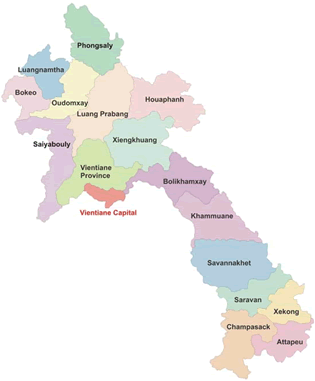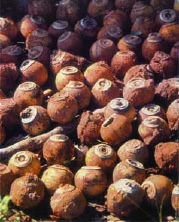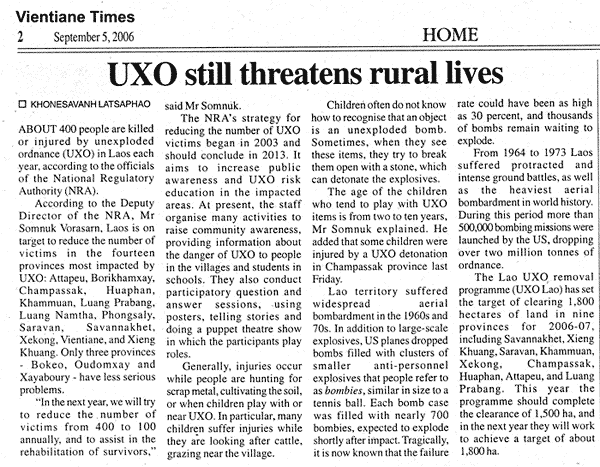Many people know little about Laos, or even where to locate it on a map. Some people think of Laos as a distant war-torn country. Others may envision the low resonating chants of monks, Buddha-filled pagodas, or the sweet, contented smiles of the Lao people. However, Laos is plagued by economic hardship and instability. It is considered one of the least developed countries in the world.



Geography:
- The Lao People’s Democratic Republic is a landlocked country in Southeast Asia, bordered by Vietnam to the east, Cambodia to the south, Thailand to the west, and Myanmar and China to the northwest.
- Laos is one of the poorest countries in Southeast Asia with subsistence agriculture, (mostly subsistence rice farming) employing an estimated 75% of the population. (U.S. Department of State, Nov. 30, 2010)
- Laos is slightly larger than Utah and most of the country is mountainous and thickly forested.
- Laos has one of the lowest population densities in Asia, with approximately 11 people per square mile.
Climate:
- The weather is warm and has two seasons: a rainy season (May to October or early November) and a dry season (Late November or December to April).
History and Culture:
- Modern Laos was a French protectorate until 1949 when it gained independence.
- By the end of Vietnam War, Laos had the notoriety of being the most bombed country per capita in the history of warfare. From 1964 to 1973, the U.S. dropped over 2 million tons of ordnance over Laos, the equivalent of one planeload every 8 minutes, 24 hours a day, for 9 years. (World Vision, March 20009) http://www.guardian.co.uk/world/audio/2008/dec/03/cluster-bomb-laos
- Lao, the official language, is tonal and is similar to Thai. It shares the Thai written script.
- Approximately 74.1% of the populations earn less than $2 USD per day.
- The country’s per capita income in 2010 was approximately $986 USD (U.S. Department of State, Nov. 30, 2010)
- A 2005 World Bank study reported that 37% of educated Laotians lived abroad, putting the country in fifth place for worst brain drain.
- In rural areas, most Lao people live in Lao traditional houses, built of wood and raised off the ground on stilts.

Healthcare:
- In 2008 the infant mortality rate (the number of infants dying before reaching one year of age, per 1,000 live births) was 48 (World Bank). Life expectancy is 65 (UNICEF 2008).
- Many villagers have no access to quality healthcare and it is impossible to afford. Traditional medicine is commonly practiced.
- The country’s geography plays a significant role in defining access to healthcare. In rural areas, people are forced to walk long distances to seek medical treatment.
- Maternal mortality rates are dramatically high in rural and remote areas where women tend to deliver at home and benefit from neither pre nor post natal care.
UXO Notes
 From 1964 to 1973 more than 580,000 bombing missions were launched over Laos by the U.S. Air Force, in a war that most of the Western world didn’t know about. As a result, more than two million tons of ordnance fell on Laos. The most widely used types of bombs were anti-personnel cluster bombs filled with 670 bomblets that were intended to explode on or shortly after impact. These bomblets, about the size of a tennis ball, are known as “bombies” in Laos. Each bombie contains around 250 steel pellets, which were meant to fire in a 2 to 4-meter radius when detonated, thus crippling but not killing enemy soldiers. The theory was that an injured soldier cost the enemy more than a dead one.
So far, the explosives have had a disastrous effect on human life, because many unexploded bombs remain in eastern and north-eastern Laos. Lots of bombs did not explode; they sank into soft mud or rice paddies, only to detonate years later when accidentally struck by farmers, playing children or buffaloes. The people most directly affected by UXO have been forced to live continuously with the problem, often with fatal consequences. Young children make up more than one quarter of the total accident victims reported since 1973. Unfortunately, the percentage of children involved in accidents is increasing. Accidents involving UXO often occur while people are weeding or plowing agricultural land, when they make fire (for cooking, for destroying rubbish, or for cleaning a field) or when they collect wood in the forest. Accidents are also caused by the attempts of villagers to open UXO for the sale or use of metal or explosives, as for many it is still more of something interesting which requires investigation, than a dangerous object.
UXO contamination has a significant effect on the development of Laos. Victims form a burden for the country’s limited medical facilities, with their need for both trauma and long-term care. Even those who recover may not always be able to do the work that is necessary in a farming village. Providing the necessary support to these people often means that the village has not enough resources for any new development work within the community. Between 1973 and 1999, 10, 649 UXO-related accidents happened in Laos. Although most of these accidents took place between 1973 and 1978, UXO accidents still continue at a rate of over 200 per year. There is still one UXO accident occurring at least every two days, and more than half of the victims die almost immediately. If victims survive, the explosion often causes severe injury, especially to the upper half of the body. UXO victims who survive face a long, difficult and painful recovery. Many survivors suffer from burns, blindness, deafness, paralysis and loss of limbs as a result of the explosion. Over half of the amputations are of the hand, lower and upper arm.
From 1964 to 1973 more than 580,000 bombing missions were launched over Laos by the U.S. Air Force, in a war that most of the Western world didn’t know about. As a result, more than two million tons of ordnance fell on Laos. The most widely used types of bombs were anti-personnel cluster bombs filled with 670 bomblets that were intended to explode on or shortly after impact. These bomblets, about the size of a tennis ball, are known as “bombies” in Laos. Each bombie contains around 250 steel pellets, which were meant to fire in a 2 to 4-meter radius when detonated, thus crippling but not killing enemy soldiers. The theory was that an injured soldier cost the enemy more than a dead one.
So far, the explosives have had a disastrous effect on human life, because many unexploded bombs remain in eastern and north-eastern Laos. Lots of bombs did not explode; they sank into soft mud or rice paddies, only to detonate years later when accidentally struck by farmers, playing children or buffaloes. The people most directly affected by UXO have been forced to live continuously with the problem, often with fatal consequences. Young children make up more than one quarter of the total accident victims reported since 1973. Unfortunately, the percentage of children involved in accidents is increasing. Accidents involving UXO often occur while people are weeding or plowing agricultural land, when they make fire (for cooking, for destroying rubbish, or for cleaning a field) or when they collect wood in the forest. Accidents are also caused by the attempts of villagers to open UXO for the sale or use of metal or explosives, as for many it is still more of something interesting which requires investigation, than a dangerous object.
UXO contamination has a significant effect on the development of Laos. Victims form a burden for the country’s limited medical facilities, with their need for both trauma and long-term care. Even those who recover may not always be able to do the work that is necessary in a farming village. Providing the necessary support to these people often means that the village has not enough resources for any new development work within the community. Between 1973 and 1999, 10, 649 UXO-related accidents happened in Laos. Although most of these accidents took place between 1973 and 1978, UXO accidents still continue at a rate of over 200 per year. There is still one UXO accident occurring at least every two days, and more than half of the victims die almost immediately. If victims survive, the explosion often causes severe injury, especially to the upper half of the body. UXO victims who survive face a long, difficult and painful recovery. Many survivors suffer from burns, blindness, deafness, paralysis and loss of limbs as a result of the explosion. Over half of the amputations are of the hand, lower and upper arm.
